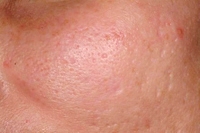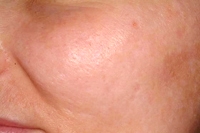Millions of people have scars from the long-lasting inflammation caused by acne. Acne scars occur most frequently in those with moderate acne to severe acne. It remains unknown why some people develop acne scars when others don’t.
Many treatment options are available to diminish the acne scars’ appearance. Depending on the type and severity of scarring, improvement can be seen in 4 to 6 weeks.
Types of Acne Scars
- Icepick. These deep pits in the skin are a classic sign of acne scarring. They are the most common type of acne scar and usually occur on the cheek. They may be shallow or deep and may be hard or soft to the touch.
- Boxcar. These depressed, crater-like acne scars are larger than icepick scars.

- Rolling scars. These acne scars are curved indentations on the skin.
- Hypertrophic scars. These acne scars are elevations or areas of skin thickening. Large hypertrophic scars may be referred to as "keloids" and tend to run in families.
The recommended treatment will depend upon the type of acne scar being treated, your skin type, your tendency to scar, and cost. Different treatments may be combined for optimal effect.
Treatment options
- Topical retinoidsSome medications applied to the skin can help smooth out very superficial acne scars but may not be effective for deeper scars.
- Dermabrasion - During this procedure, the skin is cleansed, numbed, and then vigorously rubbed with a high-speed brush to remove the top layer of skin. The result is a small injury, or "abrasion," that heals over several weeks. The healing process reshapes the skin. Dermabrasion is effective for superficial acne scars and reduces the severity of deeper scars, but it is ineffective for icepick scars. The skin may burn or feel sore and appear pink until healing is complete. The results are long-lasting. In darker-skinned people, the procedure may cause changes in skin color that require additional treatments.
- Microdermabrasion - This procedure, lasting about 10-20 minutes, uses a machine to propel small crystals through a vacuum tube onto the skin. This removes superficial layers of the skin, stimulating new skin cell growth and improving skin tone. There are few side effects and almost no recovery time, but microdermabrasion can only treat superficial acne scars. As many as six treatments may be required, 1-2 weeks apart.
- Excision and punch replacement graft - An acne scar, or cluster of small scars, is removed with a scalpel. The resulting "hole" is either sewn together or replaced with a patch of normal skin from elsewhere on the body. Excision is particularly effective for ice-pick or boxcar scars.
- Subcision - The skin is made numb and a probe is inserted beneath the acne scar, which loosens it from the surrounding tissue. This allows the scar to be elevated to the level of the normal skin. Subcision is used for depressed acne scars such as a boxed scar or rolling scar.
- Dermal fillers - Different types of "fillers" can be injected beneath a depressed acne scar to elevate it to the level of the surrounding skin. Dermal fillers are most effective for rolling scars. The benefit from soft tissue fillers usually lasts 3 to 18 months, depending on the material used. Treatment must be repeated to maintain the appearance.
- Chemical peels - During a chemical peel, a fluid is applied to the skin to remove the top layer and generate new skin growth beneath the acne scars. This lifts the scar to the level of the surrounding skin, minimizing its appearance. In general, "medium" or "deep" peels are used to treat acne, meaning that the peel is designed to affect the deeper layers of the skin. Deep chemical peels may cause lightening of the skin and a change in skin texture. Bandages may be required for several days.
- Laser skin resurfacing - Laser skin resurfacing - This removes the top portion of the acne scars and creates heat in the deeper layers of the skin. This heat causes the skin to tighten and smooth out the scar. The result is the smoothing out of the skin. Laser resurfacing is particularly helpful for boxcar scars and further improvement of acne scars treated by other methods. In some cases, only a single treatment is required; however, final results may not be seen for 12-18 months. Redness following treatment may last for several months.
If you are concerned about the appearance of acne scars, speak to your doctor about choosing an appropriate treatment for you.
Source: Vivacare
Last updated : 2/8/2021